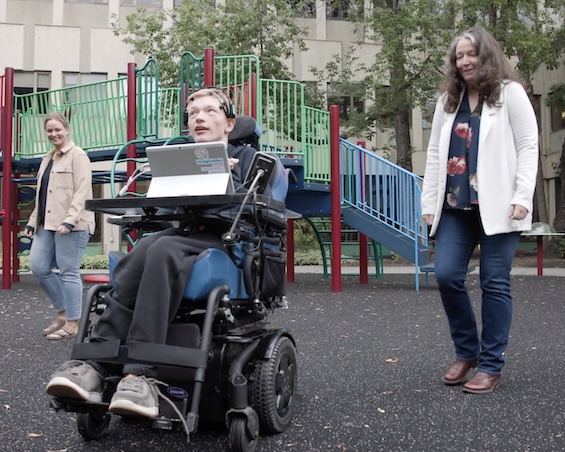Using your mind to control machinery sounds like sci-fi to some, but for Tristin Froma, it’s becoming reality. Tristin, who lives with restricted mobility, is one of several patients trialing a brain-computer interface (BCI) to drive his electric wheelchair at the Glenrose Rehabilitation Hospital.
“I love using BCI to move my wheelchair,” says the 19-year-old. “It makes me feel free.”
Tristin has cerebral palsy, a disorder that affects his ability to move freely. In his daily life, he can control his power wheelchair using sensors connected to his head rest. However, at the Glenrose, he now gets to convert his brain activity patterns into commands to control devices, including his wheelchair.
“Unlike switches or eye gaze, BCI does not rely on any physical movements,” says Corinne Tuck, an occupational therapist and clinical practice lead for assistive technology at the Glenrose.
“Patients wear a headset which can detect brain-activity patterns – and BCI converts these patterns into commands to control devices.”
Tuck is quick to point out that BCI cannot read anyone’s mind. It merely taps into the little electronic spikes in our brain that we all have every day to activate a computer signal.
Patients with restricted mobility use BCI at the Glenrose to play video games, move a robot covered in paint to create art, play music and, in Tristin’s case, to drive a wheelchair.
“When Tristin has been doing brain-computer interface driving, the main thing that we’re working on for him is to see if we can improve his endurance and the distance that he can go by himself safely,” says Tuck.
“BCI is an emerging technology. It’s exciting to see what research opportunities here could lead to real-world applications to help Tristin go farther, more independently and safely.”
The BCI program is a clinical and research program in partnership with the University of Alberta, with funding, thanks to donor support, from the Glenrose Hospital Foundation.
“Patients like Tristin have to rely on a lot of people to help them do things, but with BCI, he is doing things on his own,” says Rennie Froma, Tristin’s mom.
“He gets so excited every time he has a BCI appointment. Just seeing the smile on his face when he’s driving his wheelchair is incredible. I’m so grateful to the donors for giving him this opportunity.” n


